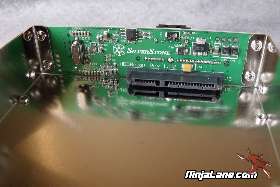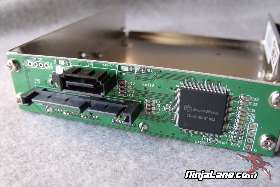After careful consideration I have decided to transfer all hardware review activities to a new domain. I purchased Hardwareasylum.com in 2012 and have been working hard to build a new and improved Ninjalane on that domain. If you are reading this you have reached one of the archived articles, news, projects and/or reviews that were left behind during the site migration.
Please update your bookmarks and be sure to visit the new and improved Ninjalane at Hardwareasylum.com
SilverStone HDDBoost Review
Author: Jim Manis
Published: Sunday, August 22, 2010
Introduction
Every once in a while a product comes along that makes you slap your forehead for how simple and helpful it can be. The HDDBoost from SilverStone is exactly that type of component and is a direct solution to the problem of slow rotational hard drives.
By now most people know about the good aspects of Solid State Drives (SSD) like amazing read bandwidth and near instant access times. The drawbacks are of course the cost and the life expectancy, which is limited to around 1 million write cycles. Under normal use the avg. user would likely see a SSD dying out well before a rotational HDD if purchased at the same time. By reducing the amount of write cycles a SSD does you can greatly prolong its lifespan. The purpose of the SilverStone HDDBoost is to give you the best of both worlds, the lifespan of a rotational drive with the fast response of an SSD.
The HDDBoost is not an add-on card but rather a proprietary device which installs inline between the HDD and the motherboard. All of the data normally stored on the HDD will pass through the HDDBoost controller before it is read or stored.
By now most people know about the good aspects of Solid State Drives (SSD) like amazing read bandwidth and near instant access times. The drawbacks are of course the cost and the life expectancy, which is limited to around 1 million write cycles. Under normal use the avg. user would likely see a SSD dying out well before a rotational HDD if purchased at the same time. By reducing the amount of write cycles a SSD does you can greatly prolong its lifespan. The purpose of the SilverStone HDDBoost is to give you the best of both worlds, the lifespan of a rotational drive with the fast response of an SSD.
The HDDBoost is not an add-on card but rather a proprietary device which installs inline between the HDD and the motherboard. All of the data normally stored on the HDD will pass through the HDDBoost controller before it is read or stored.
The size of the SSD will determine how much data the SSD can mirror. The smallest recommended size for an XP install is 16GB while for Windows 7 you should use a minimum of 32GB. For best results use the largest SSD which is practical for your storage system. The HDDBoost will automatically mirror the first SSD sized part of your HDD. The two drives then act as a RAID 1 mirrored array, only not in raid mode.
On the circuit board resides a purpose built controller which handles all of the communication between the HDD, SSD and motherboard. As you may expect there is some overhead involved which can actually lead to some applications or programs loading and/or running a little slower than when run from a bare HDD.
Over the next few pages we will take a look at the HDDBoost and put it through its paces.
On the circuit board resides a purpose built controller which handles all of the communication between the HDD, SSD and motherboard. As you may expect there is some overhead involved which can actually lead to some applications or programs loading and/or running a little slower than when run from a bare HDD.
Over the next few pages we will take a look at the HDDBoost and put it through its paces.



